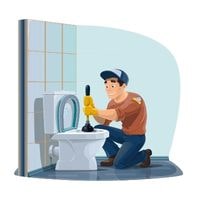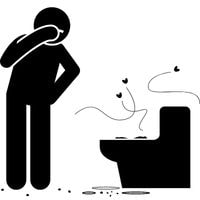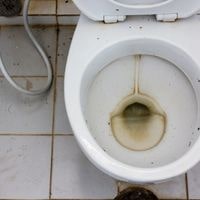Mold in toilet bowl below water line. Did you raise the lid on your toilet bowl only to discover it was coated in mold? Is your toilet bowl in the same shape? Mold may appear in various forms, textures, and colors, and it isn’t picky about what it develops on.
Mold in toilet bowl below the water line

Molds develop in a variety of environments, yet the majority of molds have similar life requirements.
Mold requires a food supply, appropriate warmth, and humidity to survive and thrive.
As a result, the toilet is an ideal environment for mold development.
It’s no surprise that our fungal pal has taken over your toilet tanks and bowl. Keep on reading to fix your problem.
Considering health purposes, molds can cause a variety of diseases. It is critical to prevent mold development in your toilet tank and bowl.

Though not all diseases are so severe, it is better to be on the safe side and remove all the mold from everywhere.
Use hydrogen Peroxide
Hydrogen peroxide is beneficial for more than just disinfecting cuts; it can also fight mold!
If you have hydrogen peroxide in your home, you’re all set to attack that toilet bowl and tank mold.
Fill the toilet bowl with a glass of hydrogen peroxide. Scrub the whole bowl with a toilet brush. Make sure you get under the rim!
Allow the hydrogen peroxide to rest in the toilet for 15 minutes before draining. Because hydrogen peroxide tends to bubble up a little when destroying microorganisms, you can start to observe tiny bubbles.
Afterward, drain the toilet. To keep the mold from developing again, repeat this method once or twice a week for a few weeks.
Remove toilet mold using vinegar
To remove toilet mold using vinegar, simply add 1 cup of vinegar into the toilet bowl and another cup of vinegar into the tank with the water.
That ensures that both your bowl and tank are clean. Then, on the interior of your toilet, spray baking soda.
Don’t be scared to get it into the toilet water and under the bowl’s rim.
Allow this to sit for around an hour. When you return after allowing the vinegar and baking soda to settle, it’s time to brush.
Scrub the inside of your toilet bowl with your toilet brush, making careful to scrub with the vinegar/toilet water as well. Allow the commode to sit for the next 15 minutes before flushing.
Allow your toilet to stay idle for a few hours after this process is finished. To keep the mold at bay, continue adding one cup of vinegar to the toilet water a few times per week.
Mold in toilet bowl below water line
White water mold in toilet bowl
To begin the elimination of mold, pour some white distilled vinegar into the toilet bowl and leave it for about two hours.
Flush the toilet a few times and then check to see if any remnants of mold remain.
If you still see mold spots on your porcelain, you’ll need to shut off the water supply valve while emptying out the tank’s contents by draining it down the toilet bowl’s drain hole (it should be at least an inch deep).
Use a long-handled cleaning brush or similar non-abrasive tool to scrub the remaining spots on the porcelain until they’re clean.
How to get rid of black mold in toilet?
Flush the toilet and wipe down around the rim, and seat with a 1:10 bleach-water solution. Scrub off any stains in the bowl with a toilet brush or non-abrasive scrubber.
Fill the tank one cup at a time with undiluted bleach, always ending each cup in flushing when the water level reaches two inches below the top of the flush valve.
Check once per week when not adding additional bleach to insure the residual is clear, noting any regularity based on how much has accumulated over that time period.
Black mold in toilet bowl diabetes
You may have heard that frequent mold buildup in your toilet can signal diabetes. This is because mold that grows in toilets often feeds off of extra sugar found in urine, which is high in people who suffer from diabetes.
Also, there’s no scientific evidence yet to support the claim. High blood sugar levels make it difficult for tissues to cleanse themselves, which makes it easier for mold to take over.
Therefore intense sweating or a long business flight may compound this problem by adhering fungal spores to sweaty skin and clothing!
Is black mold in toilet tank dangerous?
It’s not a pretty sight. Having guests over to the house, only to discover that our toilet has turned into a nightmare. Mold can begin building up rather quickly, which is why you need to do something about black mold in the toilet right away.
Most importantly, however, mold poses serious health risks, and prolonged exposure may cause harmful illnesses.
So it’s important that we take care of this problem as soon as possible before it gets worse.
How to get rid of black mold in toilet?
Toilet stains can easily be a pain to remove. One major thing you can do is regularly scrub the toilet with a non-abrasive brush or similar material.
Stronger measures that might be necessary include washing them regularly with a bleach solution – specifically one part water and ten parts bleach.
In areas where mold frequently grows, it’s always best to make sure you regularly maintain your toilet with bleach because this is safe for most surfaces.
While most building materials will withstand chlorine from bleach, avoid prolonged exposure to make sure! A clean toilet can keep almost any family healthy in more ways than they know.
Conclusion
This article has discussed all the appropriate ways to clean mold in the toilet bowl below the waterline. All the methods are concerned with your household items, so you can easily do it.
Related Guides


